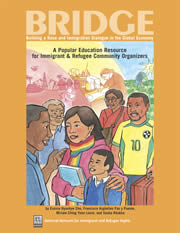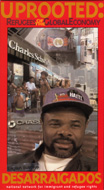 Building a Race and Immigration Dialogue in the Global Economy
Building a Race and Immigration Dialogue in the Global Economy
The BRIDGE curriculum provides resources for training, leadership development, and community education. Topics covered in BRIDGE include:
– The History of Immigration 101
– Migration, Globalization, and Workers’ Rights
– Introduction to Race, Migration, and Multiple Oppression
– Migrant Rights are Human Rights
– LGBT Rights and Immigrant Rights
– Immigrant Women’s Leadership
– Building Common Ground with Other Communities: Migration, Race and Demographic Change
– Conflict Transformation Within Community Organizing








At Freedom University (a modern freedom school for undocumented students banned from higher education in Georgia), we used the immigration history lesson with photographs and descriptions of major events in U.S. immigration history and made a giant timeline museum in our classroom from 1492 to the present. Each student was given two events to research, and the following week, they presented as experts on each event.
Combining the visual resources and powerful event descriptions along with our Freirian pedagogical model in which students are also teachers, students took ownership of the material and were able to educate each other and connect each event within a larger understanding of the shifting meanings of race and exclusion in U.S. immigration history.
Melissa, a 21-year old student at Freedom University, describes her experience with the lesson as follows: “I was assigned with researching the 1924 Johnson-Reed Act. I was shocked by the overt racial quotas that designated desirable and undesirable immigrants along lines of race. However, I felt empowered with the knowledge and was able to share my expertise with my classmates to inform our broader understanding of the relationship between race and immigration in the U.S.
This knowledge was transformative for us because while we know from experience that we are discriminated in the U.S. not only because of our status, but because we are Brown, it is often hard to articulate that the two are connected without knowing the history of immigration policy. However, because of this comprehensive history lesson on immigration and race, we are now better able to connect the dots across generations to argue how “undocumented” is simply modern racial code that justifies our exclusion in a so-called “post-racial era.” This is invaluable to us as we engage with the world and assert our human rights to education, voting, and fair wages.